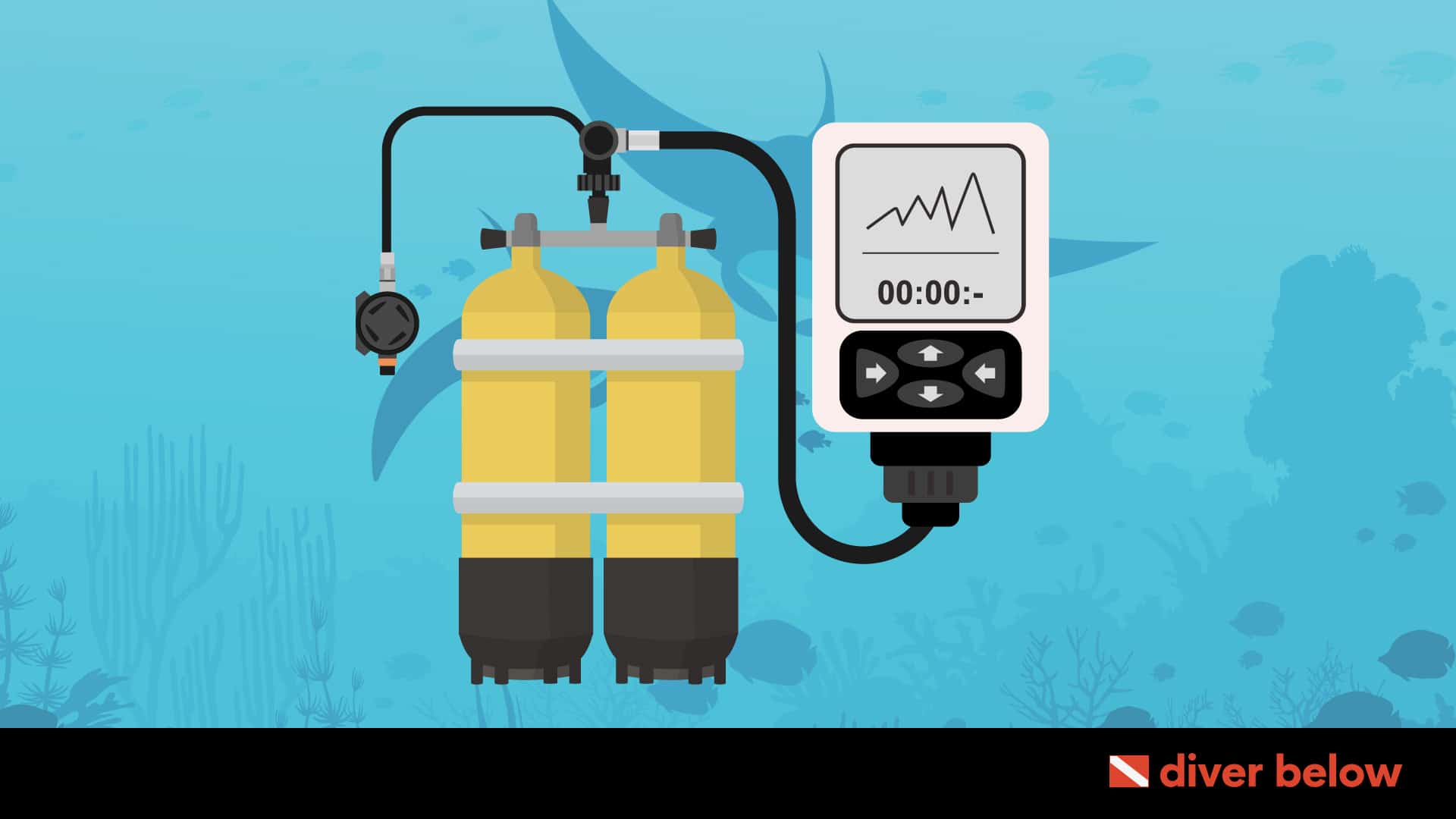Scuba diving is an adventurous and unique hobby made better by technology.
We’ve come a long way in diving technology over the years to make sure that scuba diving is safer and more enjoyable.
One piece of tech that has helped with this is the air integrated dive computer.
But, what is an air integrated dive computer?
Which of the computers on the market right now will best match the scuba diving that you enjoy?
Let’s look at some of the best products out there right now for 2021.
Contents
- What Is an Air Integrated Dive Computer?
- Differences Between Air Integrated Dive Computers and Not
- Is an Air Integrated Dive Computer Worth It?
- Best Air Integrated Dive Computers
- Best Air Integrated Dive Computers for Beginners
- Cheapest Air Integrated Dive Computers
- Best Air Integrated Wrist Dive Computers
- Best High-End Air Integrated Dive Computers
- How to Choose the Best Air Integrated Dive Computer for You
- Final Thoughts
What Is an Air Integrated Dive Computer?
Air integrated dive computers are computers built specifically to aid divers in their dives.
While most divers will use an air pressure gauge to measure the gas left in their tanks, an air integrated computer can do the same job as a pressure gauge plus more.
These computers connect to a transmitter that gives information about the gas tank and the diver’s environment.
What Does Air Integrated Mean?
Air integration refers to the dive computer’s ability to read the air pressure in a gas tank.
These computers use sensor data to give divers a reading on air pressures inside the tank.
From there, the air integration data can be displayed on the computer’s screen.
Most dive computers take the shape of a watch, meaning they fit securely over the wrist of the wearer.
This gives the diver an easy way to review tank pressure in addition to any of the other functions the dive computer possesses.
How Does an Air Integrated Dive Computer Work?
The main way an air integrated dive computer works is by connecting to pressure sensors on the gas tank.
These computers connect through either a hose or a hoseless connection.
With a hose connection, the dive computer hooks up via a physical connection to the first stage of the tank.
The mechanical parts of the tank provide data on pressures inside of the tank to the computer.
Because these connections can be bulky, they work well for console-mounted computers instead of the wrist-wearable models.
Meanwhile, a hoseless connection uses a Bluetooth connection to get the data to the computer.
This wireless air integration connects to a wrist dive computer that displays the information for the diver.
By cutting back on the bulk, the diver can swim with less gear strapped to their back.
Differences Between Air Integrated Dive Computers and Not
When you start looking at air integrated dive computers, it can be off-putting due to the price.
In addition to the computer, you need to buy a transmitter that can provide data to the dive computer.
If you’re going to do that, why wouldn’t you instead get a non-integrated computer that needs fewer connections?
The main reason is the expanded safety features in an air integrated dive computer.
These devices allow you to safely track your air usage.
This info is especially helpful for trimix divers that dive down deep and need to ensure they have the gases they need to safely ascend to the surface.
Many air-integrated dive computers also have extra features that are good both in and out of the water.
Bluetooth connectivity, a user-replaceable battery, a 3D compass, and other useful tools are programmed into many of these computers.
Each of these can be great in and out of the water for all sorts of outdoor excursions or at-home convenience.
Is an Air Integrated Dive Computer Worth It?
Whether you are a technical diver or a recreational diver, having an air integrated dive computer can help ensure your dives are safe and enjoyable.
Because these computers can act as diving aids, they offer information to a diver to keep themselves safe while submerged.
Some models are able to provide feedback during ascension to make sure that decompression sickness doesn’t set in.
Others will offer your total depth, have GPS signals, and other safety and environmental data to the diver.
Technical divers especially will benefit from one of these computers.
The ability to retrieve a dive log, bring up an integrated compass during a scuba dive, or switch between multiple gas mixes will let these divers stay in the water longer and more safely.
Best Air Integrated Dive Computers
While there are plenty of air integrated dive computers out there, let’s take a look at the best ones for you.

What We Looked For
Different divers will have different needs.
A recreational diver will need fewer tools than a more technical diver.
So, here are the different facets we looked at when picking the best air integrated dive computers on the market:
1. Overall Features
The standard features that come with a dive computer are great, but we also looked at the tools you can use outside of the dive as well.
A dive computer that can be used for more than just your dives will give you more bang for your buck.
It can also add some extra conveniences to your life.
2. Price
As you go up in the number of features and reliability, the price of the dive computer goes up, too.
We recognize that different divers will have different budgets.
So, to make sure that all levels of divers can find something useful for them, we’ve broken up the dive computers featured below by price category.
3. Use of Computer
Finally, the ease of use of the dive computer is a big consideration.
After all, if a dive computer is difficult to use or doesn’t respond to input underwater, it becomes a liability instead of an asset.
We also looked at how easy the different tools in the dive computer were to access when submerged.
Best Air Integrated Dive Computer Brands
Plenty of manufacturers out there make air integrated dive computers.
However, we found that these brands consistently made out top lists:
1. Shearwater
While their dive computers tend to be on the basic side, they are reliable and worth it for the price point.
Also, because the dive computers they offer are more basic, they tend to be on the cheaper side as well. This makes the company a great choice for newer divers.
2. Oceanic
A little higher up than Shearwater, Oceanic is a well-known recreational diving brand.
Their gear is still on the basic end, but it is reliable and tries to be innovative with each of its new releases.
3. Garmin
Known for their GPS devices, Garmin also makes solid air integrated dive computers.
The devices that Garmin offers also feature their solid GPS technology in addition to the bells and whistles you would want as a more technical diver.
4. SUUNTO
This Finnish company has a wide range of dive computers, so their products could appeal to a diver of any skill set.
Their products are reliable, durable, and varied enough to ensure that there is a product for anyone.
Best Air Integrated Dive Computers for Beginners
For those out there that are just getting started with diving, these dive computers will be the best options for you to consider:
SUUNTO D6i Novo Zulu Wrist Computer
- Steel case and sapphire crystal glass with antireflective coating, full continuous decompression
- Gas-switching between up to three gases, five modes: air, nitrox, gauge, free and off, innovative app
- Transmitter is compatible with suunto air-integrated dive computers, green led light to indicate date
- Battery life approx. 2 years (100 dives/year), monitor tank pressure and air consumption data wireless
Although similar to the Suunto D5, the D6i features tools that are great for folks just getting into diving.
Specs
Here’s a summary of what the Suunto D6i has to offer:
- Has standard air, nitrox, gauge, and freediving modes
- Wrist-mounted
- Contains a standard digital compass
- Can connect to Suunto DM5 software on PC/Mac via USB cable
What We Like
These are the things we liked about this dive computer:
- Incredibly long battery life
- Built-in dive planner helps chart out dives before submerging
- Dive logs are easy to read and readily accessible after a dice
What We Don’t Like
Here is where the Suunto might fall short:
- Limited features mean this isn’t great for technical divers
- Transmitter for hoseless air integration costs extra
- No functions outside of the dive computer capabilities
Suunto Cobra 3 Air Integrated Computer
- Operating modes: air, nitrox and gauge, programmable for 21% to 50% oxygen mixtures
- Displays oxygen partial pressures from 17.4 psi to 23.2 psi (1.2 to 1.6 bars) | altitude adjustable
- Maximum depth display: 492' (150 meters) | operational depth display: 262' (80 meters) | 12 or 24-ho
- Temperature gauge to 1.5 degreef (1 degreec) accuracy | imperial/metric programmable | decompression
- 36 hour profile and logbook memory | back lite display, easy to read in low light & night conditions
Unlike many of the dive computers on this list, the Suunto Cobra Air 3 does not mount to the wrist.
But, it has plenty of other features that make it stand out:
Specs
- Dive sidemount capability
- Features air, nitrox, and gauge driving gas modes
- Electronic 3D compass
What We Like
These features are what make the Cobra 3 Air stand out:
- One of the more inexpensive dive computers on this list
- Tiltable 3D compass greatly improves navigation when underwater
- Dive simulator and planner built directly into the hardware.
What We Don’t Like
However, there are a couple of things this computer is lacking:
- Limited gas and dive modes compared to other models
- Requires physical connection to the air tank in order to check tank pressure
- Protection screen isn’t scratch-resistant
Cheapest Air Integrated Dive Computers
If you want to stay on a tighter budget, then these dive computers are the ones you might consider:
Suunto Vyper Novo Lite Computer
This lightweight dive computer might not have all the features the more expensive models do, but it is still a solid consideration for a diver on a budget:
Specs
Here are some of the standout specs for the Vyper Novo Lite:
- A wrist-mounted dive computer with hoseless integration
- Five air modes: air, nitrox, gauge, free dive, and off
- 3D digital compass
What We Like
Here are the things to like about this dive computer:
- Built-in dive planner despite the low price point
- The menus on the computer are intuitive and easy to navigate
- The largest number of diving modes for the price point
What We Don’t Like
Still, there are some big downsides to this product:
- Suunto no longer manufactures this product, making it hard to find.
- Tank transmitter sold separately
- Suunto’s software no longer supports this product, making it hard to access dive logs
Oceanic OCi Dive Computer
While it might not be the fanciest dive computer, the Oceanic OCi dive computer is one of the best bangs for the buck you can get.
Specs
Here are some of the standard features of this product:
- A wrist-mounted dive computer with a basic digital interface
- Air, nitrox, free, and gauge diving modes
- Basic 3D compass
What We Like
These are the things to love about the Oceanic OCi:
- The cheapest price point of any other dive computer listed here
- Has many of the features of other Oceanic products, including their dive mode and Z+/DSAT safety algorithms.
- Over 300 hours of diving battery life
What We Don’t Like
Still, there are a few things we didn’t like about it:
- The wireless transmitter for your tank is sold separately.
- Basic digital display can be hard to read when underwater or in the dark
- The display is also smaller compared to other wrist-mounted dive computers
Best Air Integrated Wrist Dive Computers
As the best overall, these dive computers combine a reasonable price with a good suite of features and tools:
SUUNTO Eon Core Wrist Computer with USB
- Clear color display w/large, prominent digits & intuitive menu logic
- Fully charged provides 10 to 20-hours of dive time
- Dive modes: gauge, air, nitrox, trimix and ccr (fixed point)
- Power: user replaceable 1/2aa 3v lithium battery
- On-board digital up to 45 degree tilt compensated 3d compass
The Eon Core comes in both a wrist-mounted and side-mounted model.
The wrist model wins out here for these reasons:
Specs
These are some of the specs that really stand out for the Eon Core:
- A wrist-mounted computer that resembles the side-mounted model
- Air, nitrox, trimix, and rebreather dive modes are available
- Digital compass with a huge tilt compensation built into the device
What We Like
Here’s what we like about the Suunto Eon Core:
- Large color display that is easy to read when in the water
- Allows for deep diving on multiple gas settings
- The battery runs for up to 20 hours when all functions are on
What We Don’t Like
Still, there are a few negatives to consider about this product:
- The Suunto software has problems that affect connectivity with this device
- Only works with the Suunto Pod transmitter, not the older models
- Sunnto Pod transmitter is sold separately
Scubapro Galileo Luna Complete
- Hoseless gas integration, full-tilt digital compass with bearing memory
- Extra large dot-matrix display, updatable processor that can be reprogrammed via infrared by the use
- En certification to 1082 feet (330 meters)
- User-replaceable battery with tissue loading memory
- Galileo's memory chip can hold over 100 hours of dive profile data and 100 bitmap images as a wreck
Trying to stay true to its name, the Scubapro Galileo Luna Complete tries to be everything you need when out on your dives.
Specs
Here are the specs to look out for with this computer:
- Wrist-mounted
- Supports air, nitrox, trimix, and gauge dive modes natively, with the freediving update available from the website
- Full-tilt digital compass
What We Like
Here are the things we really like about this dive computer:
- Operates at a depth of up to 1000 feet for incredible excursions
- Active backlight keeps the plain digital interface readable
- Predictive Multi-Gas and Heart Rate Monitor upgrades improve the versatility of this computer
What We Don’t Like
Still, there are some things we didn’t like about this dive computer:
- The computer is bulky on the wrist, making it somewhat uncomfortable
- The upgraded functions require a firmware update right out of the box to use them
- No native software for dive logs means you’ll have to go outside the Scubapro brand to access them
Best High-End Air Integrated Dive Computers
Finally, we reach the top end of performance for air integrated dive computers.
Let’s take a look at what the high-end products look like:
Shearwater Teric
Although Shearwater has plenty of recreational diver dive computers, the Shearwater Teric is a great choice for technical divers.
Specs
These are some of the highlights for the Shearwater Teric:
- Wrist-mounted
- Two air transmitter connectivity
- 3D compass with tilt compensation
- Nitrox, trimix, and rebreather compatibility
- Bluetooth connectivity to connect to smart devices
What We Like
Here’s what we like about this dive computer:
- Plenty of features to ensure safe, effective dives
- Ability to access 500 hours worth of dive logs
- Six diving modes included
What We Don’t Like
Not everything is perfect with the Shearwater Teric, though:
- Expensive, putting it outside many people’s budgets
- Doesn’t come with a transmitter
- Short battery life when all features are in use
Garmin Descent Mk2
- Advanced, watch-style dive computer with 1.4 color sunlight-readable display (36% larger than previous
- Battery life: up to 80 hours in dive mode, up to 16 days in smartwatch mode and up to 15 hours in gp
- Features enhanced wrist-based heart rate estimates and pulse ox (this is not a medical device)
- Includes built-in support for multiple sports apps, advanced training features, contactless payment,
- Dive log lets you store and review data from up to 200 dives right on your wrist and share and review
- Six dive modes as well as multi-gnss support and abc sensors including an underwater compass know
Although Garmin hasn’t been making dive computers for a long time, the Garmin Mk2i is an incredible product for technical divers.
Specs
Here’s an overview of what the Garmin Mk2i looks like:
- Wrist-mounted
- Connectivity to up to five T1 air transmitters via hoseless air integration
- Single and multiple gas dive modes, as well as CCR, apnea, and gauge dive modes
- Digital compass with three axes
What We Like
These are the features that stood out to us:
- Sonar-based connectivity means longer connection distances are possible.
- Entry and exit point tracking via GNSS
- Performance and sport app integrations for us outside of the water
What We Don’t Like
However, there were a few downsides to the Garmin Descent Mk2i:
- The high-end price point of $1,500 including the transmitter
- Can only connect to Garmin app store
- Most extra features require an app download since they aren’t native to the dive computer
Oceanic ProPlus X Console Dive Computer
Although this is a side-mounted model, the Oceanic ProPlus X has a lot that it offers:
Specs
These are the features that really stand out for this dive computer:
- Side-mounted, with a hose connection to the tank
- Air, nitrox, and gauge dive modes
- TFT display makes this computer easy to read no matter your depth or conditions
What We Like
What really stands out to us are these features:
- Integration with the DiverLog app makes it easy to review dive logs
- The Z+ and DSAT algorithms let you program what kind of dive you want to have with no headaches
- Battery lasts for 35 to 60 hours – plenty of time for a weekend vacation
What We Don’t Like
Still, there are a few downfalls to the ProPlus X from Oceanic:
- Very basic compass incorporated into the computer
- Not as many dive mode options as other brands at the same price point
- Some users report compatibility issues with the DiverLog software
How to Choose the Best Air Integrated Dive Computer for You
With all the options out in the market for dive computers, it can be tough to make the right choice.
While we can’t choose a dive computer for you, we can leave you with a few things to think about when considering which air integrated dive computer to grab for yourself:
Consider Your Diving Level
While divers of all types can benefit from an air integrated dive computer, different divers will need different toolsets.
Arecreational diver might not need more than a few preset diving modes and a tank pressure monitor.
Meanwhile, a more technical diver might want extra aids like decompression timers to make sure they execute their dive safely.
Think about what you want out of your diving computer before purchasing one.
While it can be exciting to grab the fanciest one off the shelf, it’s better to match the gear to your dives.
You can always upgrade to a new computer if you outgrow a more basic one.
Consider What You’ll Use it For
Much like with diver experience, an air integrated dive computer should match what you’ll be doing during your dives.
Many of the computers we’ve covered here have a wide arrangement of tools to help you.
But, if you only need a few of those tools, you might be better served with a more basic model.
Plus, different dive computers are graded for different depths.
If you don’t plan on doing deep dives, a computer that helps with those depths might not be needed.
Likewise, if you don’t plan on switching from nitrox for shallow dives, then support for custom gas mixtures isn’t helpful.
Consider How Your Gear is Set Up
Air integrated computers can be set up for either a hosed or hoseless connection.
Because of this, you’ll have to figure out if the rest of your gear is compatible with the dive computer you want to buy.
If you don’t plan on diving fair beyond your entry point, then a physical connection might not be a bad thing.
However, some divers want to go further from their starting point, which can make a physical connection a hindrance.
Decide what you want your dives to look like and how that matches up with the gear you have right now.
That will help point you towards the dive computer that will work best for you.
Consider Your Budget
While dive computers can be expensive, there is still a price range between the basic models and more advanced ones.
When you’re choosing a dive computer to match with your gear, you should also consider the cost of the dive computer.
This is especially true for newer divers.
While a fancy dive computer feels like an integral piece of gear to have, you want to ensure you buy high-quality diving gear that is necessary.
Your tanks, connectors, and so forth should be reliable first before you splurge on a dive computer.
Consider The Gas Type You’ll Dive With
As you advance into more technical diving, the gas mixture that you use will change.
While nitrox is great for shallow diving, trimix becomes the king for deeper depths.
For divers that want to mix things up, gas switching becomes a feature that you need to consider.
Many higher-end dive computers will also have dive mode presets and gas mixtures pre-programmed into them.
This feature could be good for divers that want to change things up between dives without having to program the settings into the computer themselves.
If you don’t need these features, then skipping over dive computers with them makes sense.
That way, you can focus your money on a computer that will suit your needs.
Final Thoughts
When it comes to air integrated dive computers, the best choice you can make is the one that matches your needs.
It’s hard to find a dive computer that is cheap.
Even the inexpensive options will still cost hundreds of dollars.
Still, with a little bit of research and understanding of what you need, you can find a dive computer for your trips.













